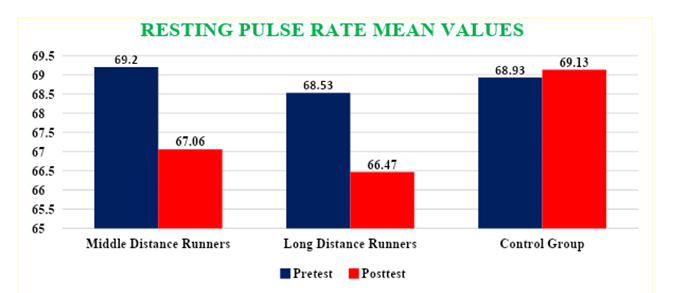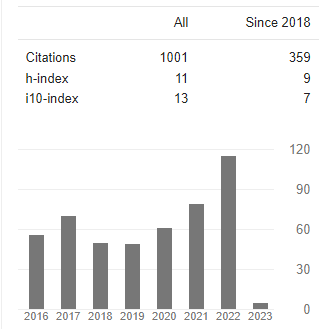EFFECT OF WEIGHT TRAINING ON RESTING PULSE RATE AMONG MIDDLE DISTANCE AND LONG-DISTANCE RUNNERS OF OSMANIA UNIVERSITY
Abstract
The purpose of the study was to explore the effect of Weight training on Resting Pulse Rate among Middle Distance and Long-Distance runners of Osmania University. Total 90 male athletes of Middle Distance and Long-Distance runners were randomly selected as subjects from Degree & PG colleges which are affiliated to Osmania University, Hyderabad, Telangana and their age ranged between 18-22 years. The study was formulated as pre and post-test random group design, in which N=45 male athletes of Middle-Distance runners and Long-Distance runners divided into three equal groups as Group 1 (n = 15) Middle Distance Runners Group, Group 2 (n = 15) Long Distance Runners Group, Group 3 (n = 15) Control group. The experimental groups 1 & 2 underwent 12 weeks of Weight training i.e., 3 days/week and Control groups did not go for any specific training. Pre and Posttest was administrated prior and after training period on Resting Pulse Rate for the three groups respectively. The statistical tests Mean, Standard Deviation, ‘t’ test, ANCOVA and Scheffe’s Post Hoc test was carried out with the help of the software package of social science (SPSS 20.0 version). With the effect of 12 weeks of Weight training, it was found that there was a significant difference on Resting Pulse Rate between Experimental groups and Control group.
Downloads
References
Araujo, C. G., and Scharhag, J. (2016). Athlete: a working definition for medical and health sciences research. Scand. J. Med. Sci. Sports. 26, 4–7. doi: 10.1111/sms.12632
Balyi, I., Way, R., and Higgs, C. (2013). Long-Term Athlete Development. Champaign: Human Kinetics.
De Ste Croix, M. B., Armstrong, N., Welsman, J. R., and Sharpe, P. (2002). Longitudinal changes in isokinetic leg strength in 10-14-year-olds. Ann. Hum. Biol. 29, 50–62. doi: 10.1080/03014460110057981
Harries, S. K., Lubans, D. R., and Callister, R. (2012). Resistance training to improve power and sports performance in adolescent athletes: a systematic review and meta-analysis. J. Sci. Med. Sport 15, 532–540. doi: 10.1016/j.jsams.2012.02.005
Mandeep Singh (2010). Evaluation And Improvement Of Sports Techniques Through Biomechanical Updated Analyzing Technology, University News, Journal of Higher Education Association of Indian Universities, Association of Indian Universities, Vol:48:Issue.05;2010 Pp45-57, 2010
Mandeep Singh Nathial, A Study of Adjustment and Emotional Intelligence of University Coaches in India, American Journal of Applied Psychology. Volume 3, Issue 6, November 2014 , pp. 122-126. doi: 10.11648/j.ajap.20140306.11
Nathial, Mandeep Singh. A COMPARATIVE AND ANALYTICAL STUDY OF SELF-ESTEEM AND JOB SATISFACTION IN ATHLETES AND NON ATHLETES. Journal of Advances in Social Science and Humanities, 2(10).https://doi.org/10.15520/jassh210123
Singh, M., Kour, R., & Kour, A.,. A collaborative diversified investigation of respective responses of sports person coaches and organizations on criminalization of doping.International Journal of Health Sciences,6(S3), 11295–11310. https://doi.org/10.53730/ijhs.v6nS3.8641
Mandeep Singh., Assessment of Vocational Interests of Pahadi&Bakarwal School Students In Relation To Their Gender. Int J Recent Sci Res. 9(3), pp. 24817-24819. DOI: http://dx.doi.org/10.24327/ijrsr.2018.0903.1731
Dr. Mandeep Singh, 2017. “A study of awareness of inhouse doping errors among national level players and sports administrators in J&K state of India”, International Journal of Current Research, 9, (01), 45226-45227. http://www.journalcra.com/sites/default/files/issue-pdf/20036.pdf
Mandeep Singh, 2019; “Effect of Mobile Screen Psychomotor Digital Image Motivators in Person Technique in Reducing Anxiety Level of Intervarsity Players of Cluster University Jammu, Blue Eyes Intelligence Engineering and Sciences Publication (BEIESP). Volume-9 Issue-1, October 2019, PP: 3750-3752, DOI: 10.35940/ijeat.A9811.109119. https://www.ijeat.org/portfolio-item/A9811109119/
Mandeep Singh. (2018). THE AWARENESS OF MOVEMENT AND FITNESS SCIENCES AMONG SCHOOL, UNDER GRADUATE AND POST GRADUATE LEVEL STUDENTS: EMPOWERING EDUCATION THROUGH PHYSICAL EDUCATION. European Journal of Physical Education and Sport Science, 4(3).https://doi.org/10.5281/zenodo.1218149
SINGH SIDHU, A., & SINGH, M. (2022). KINEMATICAL ANALYSIS OF HURDLE CLEARANCE TECHNIQUE IN 110M HURDLE RACE. International Journal of Behavioral Social and Movement Sciences, 4(2), 28–35. Retrieved from https://ijobsms.org/index.php/ijobsms/article/view/267
Singh, A., & Singh , D. M. (2013). PROMOTION OF RESEARCH CULTURE –ENHANCING QUALITY IN HIGHER EDUCATION. International Journal of Behavioral Social and Movement Sciences, 2(2), 202–208. Retrieved from https://ijobsms.org/index.php/ijobsms/article/view/152
SINGH, M., & SINGH SIDHU, A. (2016). A COMPARATIVE STUDY OF BODY COMPOSITION AND RELATIVE HEALTH STATUS AMONG RESIDENT AND NON-RESIDENT STUDENTS IN DIFFERENT SCHOOLS OF J&K. International Journal of Behavioral Social and Movement Sciences, 5(3), 08–13. Retrieved from https://ijobsms.org/index.php/ijobsms/article/view/320
Singh Nathial, D. M. (2012). ANALYZING THE CREDIT BASED SYSTEM IN PHYSICAL EDUCATION. International Journal of Behavioral Social and Movement Sciences, 1(3), 172–176. Retrieved from https://ijobsms.org/index.php/ijobsms/article/view/37
SHARMA, N. P., & SINGH, M. (2014). SENIOR AGE GROUP RELATIVE EXERCISES AND IMPACT ON THEIR LIFESTYLE. International Journal of Behavioral Social and Movement Sciences, 3(04), 78–82. Retrieved from https://ijobsms.org/index.php/ijobsms/article/view/246
CHAND PURI, P., MISHRA, P., JHAJHARIA, B., & SINGH, M. (2014). COORDINATIVE ABILITIES OF VOLLEYBALL IN DIFFERENT AGE GROUPS: A COMPARATIVE STUDY. International Journal of Behavioral Social and Movement Sciences, 3(3), 56–68. Retrieved from https://ijobsms.org/index.php/ijobsms/article/view/228
Dr.Mandeep Singh & J N Baliya, 2013; “A study of family stress among working and non-working parents”, International Journal of Research in Social Sciences.Vol 2, 2. 194-201. https://indianjournals.com/ijor.aspx?target=ijor:ijrss&volume=2&issue=2&article=013
Lloyd, R. S., Faigenbaum, A. D., Stone, M. H., Oliver, J. L., Jeffreys, I., Moody, J. A., et al. (2014). Position statement on youth resistance training: the 2014 International Consensus. Br. J. Sports Med. 48, 498–505. doi: 10.1136/bjsports-2013-092952
Pfeiffer, R., and Francis, R. (1986). Effects of strength training on muscle development in prepubescent, pubescent and postpubescent boys. Phys. Sports Med. 14, 134–143.
Rhea, M. R. (2004). Determining the magnitude of treatment effects in strength training research through the use of the effect size. J. Strength Cond. Res. 18, 918–920. doi: 10.1519/00124278-200411000-00040
Schmidtbleicher, D. (2004). “Training for power events,” in Strength and Power in Sport, ed P. V. Komi (Oxford: Blackwell Science Ltd.), 381–395.
Winter, E. M., Abt, G., Brookes, F. B., Challis, J. H., Fowler, N. E., Knudson, D. V., et al. (2016). Misuse of “power” and other mechanical terms in sport and exercise science research. J. Strength Cond. Res. 30, 292–300. doi: 10.1519/JSC.0000000000001101
Abdalkareem Jasim S, Singh M, Al-Dhalimy AMB, Zwamel AH, Jawad IA, Shalaby NS. The Impact of Chronic Exercise on Cognitive Function: An Overview of Reviews. Iran J Psychiatry. 2024;19(4):463-472. https://ijps.tums.ac.ir/index.php/ijps/article/view/3895
Yasmin Basheer Ahmed, Saade Abdalkareem Jasim, Yasser Fakri Mustafa, Beneen Husseen, Thoraya Mahbas Diwan, Mandeep Singh, The effects of propolis supplementation on lipid profiles in adults with metabolic syndrome and related disorders: A systematic review and meta-analysis of randomized controlled trials, Human Nutrition & Metabolism,Volume 37,2024,200276,ISSN 26661497,https://doi.org/10.1016/j.hnm.2024.200276.(https://www.sciencedirect.com/science/article/pii/S266614972400038
Alameri AA, Ghanni MU, Ali A, Singh M, Al-Gazally ME, Almulla AF, Alexis Ramírez-Coronel A, Mustafa YF, Gupta R, Obaid RF, Gabr GA, Farhood B. The Effects of Curcumin on Astrocytes in Common Neurodegenerative Conditions. Mini Rev Med Chem. 2023;23(22):2117-2129. doi: 10.2174/1389557523666230502143131. PMID: 37132107. https://pubmed.ncbi.nlm.nih.gov/37132107/
Singh, M., Kadhim, M.M., Turki Jalil, A. et al. A systematic review of the protective effects of silymarin/silibinin against doxorubicin-induced cardiotoxicity. Cancer Cell Int 23, 88 (2023). https://doi.org/10.1186/s12935-023-02936-4 https://cancerci.biomedcentral.com/articles/10.1186/s12935-023-02936-4
Mandeep Singh Nathial, Analysis of set shot in basketball in relation with time to perform the course and displacement of center of gravity, American Journal of Sports Science, Vol.2 Issue.5 pp: 122-126 (2014). Retrieved from https://www.sciencepublishinggroup.com/journal/paperinfo.aspx?journalid=155&doi=10.11648/j.ajss.20140205.13
Singh, M., Kour, R., & Kour, A.,. A collaborative diversified investigation of respective responses of sports person coaches and organizations on criminalization of doping.International Journal of Health Sciences,6(S3), 11295–11310. https://doi.org/10.53730/ijhs.v6nS3.8641
Singh, A., & Singh , D. M. (2013). PROMOTION OF RESEARCH CULTURE –ENHANCING QUALITY IN HIGHER EDUCATION. International Journal of Behavioral Social and Movement Sciences, 2(2), 202–208. Retrieved from https://ijobsms.org/index.php/ijobsms/article/view/152
SINGH, M., & SINGH SIDHU, A. (2016). A COMPARATIVE STUDY OF BODY COMPOSITION AND RELATIVE HEALTH STATUS AMONG RESIDENT AND NON-RESIDENT STUDENTS IN DIFFERENT SCHOOLS OF J&K. International Journal of Behavioral Social and Movement Sciences, 5(3), 08–13. Retrieved from https://ijobsms.org/index.php/ijobsms/article/view/320
Singh Nathial, D. M. (2012). ANALYZING THE CREDIT BASED SYSTEM IN PHYSICAL EDUCATION. International Journal of Behavioral Social and Movement Sciences, 1(3), 172–176. Retrieved from https://ijobsms.org/index.php/ijobsms/article/view/37
SHARMA, N. P., & SINGH, M. (2014). SENIOR AGE GROUP RELATIVE EXERCISES AND IMPACT ON THEIR LIFESTYLE. International Journal of Behavioral Social and Movement Sciences, 3(04), 78–82. Retrieved from https://ijobsms.org/index.php/ijobsms/article/view/246
CHAND PURI, P., MISHRA, P., JHAJHARIA, B., & SINGH, M. (2014). COORDINATIVE ABILITIES OF VOLLEYBALL IN DIFFERENT AGE GROUPS: A COMPARATIVE STUDY. International Journal of Behavioral Social and Movement Sciences, 3(3), 56–68. Retrieved from https://ijobsms.org/index.php/ijobsms/article/view/228

Copyright (c) 2023 Tagulla Venkanna, L. B. Laxmikanth Rathod

This work is licensed under a Creative Commons Attribution 4.0 International License.














